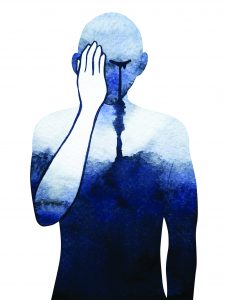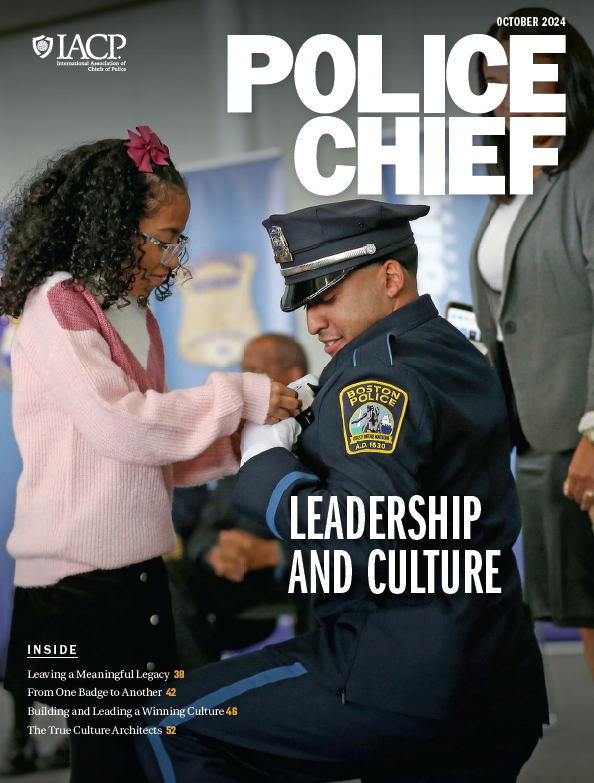From chaos and misfortune to second guesses and the ultimate sacrifice—police work is in a constant state of volatility, uncertainty, complexity, and ambiguity (VUCA). VUCA is a term coined by the War College in the early 1990s.1 VUCA encompasses a host of personal and organizational stressors, which fall on police executives to understand and prepare for to minimize the resulting disruption and destabilization.2 To mitigate the effects of VUCA on police agencies, police leaders have a responsibility to build a resilient police force. One of the best ways to reduce VUCA’s effect on organizations is to adequately understand how to build personal resilience for better operational outcomes while simultaneously improving officer well-being in general. VUCA’s influence on the police cuts deeper than the acronym might state.
There are a host of detrimental costs associated with a non-resilient police force. Cynicism, relationship issues, substance abuse, and even death are the costs for officers who are ill-equipped to deal with the stressors of the job. Research in the expanding field of neuroplasticity and positive psychology has developed new insights that can benefit public safety in keeping officers healthy and vibrant in mind and body to ensure that they are prepared to take on an ever-complicated and chaotic workplace. The field of positive psychology has shown that happiness in the mind influences resilience in the body. Happiness guards against disease and deterioration of organ systems. It therefore stands to reason that to the same factors that promote happiness may also inoculate officers against stress.
The emerging science of neuroplasticity reveals that the brain is constantly changing. There are conditions under which deeply embedded emotional memories can be changed and updated; for instance, fear can be stripped out using a memory mismatch strategy as in Coherence Therapy or the reconsolidation of traumatic memories (RTM) protocol.3 Other emotional systems can be strengthened. Although genetic temperaments are deeply rooted in personality, character is more easily influenced. Character involves social learning as well as behavioral reinforcement, which indicates that it can change. Millions of people in self-help communities strengthen their own character to override addictive impulses.4 Similarly, character in officers can be strengthened as a bulwark against debilitating stress.
Antifragility
To build this resiliency, the authors propose a strategy using the concept of antifragility. “Antifragility” is a term coined by statistician and author Dr. Nassim Taleb in his seminal book Antifragile.5 Taleb explains how a highly centralized, rigid, and therefore fragile system can fracture when visited by a “black swan” (totally unexpected) challenge In the realm of law enforcement, a black swan event might be, for instance, a mass shooting. Trauma can also fracture character. The sight of a child’s burned body, an encounter with a suicidal adolescent, or the failure to prevent the death of a partner can fracture an officer’s mind into disparate pieces. The technical term is “dissociation,” a central feature of Post-Traumatic Stress Disorder.
There is also a more insidious form of emotional degradation. Think of the expression “nibbled to death by ducks.” In this case, character isn’t “fractured” by trauma but rather worn away by the slow compounding of daily stress. Many officers discount this potential effect because society has trained them to be “strong” and fearless. The reality, however, is that stress is eating away at their emotional foundation. Police agencies need a resilience training strategy that can handle this threat—ideally, a strategy that can bypass total reliance on the so-called helping professions (e.g., therapy and mental health services). When possible and practical, self-help and mutual help are the first way to go.
Resilience Strategy
One strategy for strengthening character resilience involves four dimensions of antifragility:
- diversified emotional resources
- capacity to generate and accumulate resources
- capacity to repair damage
- ability to strengthen oneself
These antifragile properties have parallels in in organic life. The term “resources” refers to emotionally supportive memory. Emotional resources are filed in the unconscious. Research on happiness reveals that people who are strongly motivated by virtuous values will show greater anti-viral and anti-inflammatory genetic expression.6 This is not an entirely new concept—neurologist and psychologist Viktor Frankl may have been the first to explicitly make the connection between meaning and stress resilience in his 1946 book, Man’s Search for Meaning.7 Strengthening antifragile character will necessarily involve strengthening implicit values and meaning. Practical methods to strengthen character are still evolving, but the following are possibilities for strengthening officers’ resilience.
Diversified Emotional Resources
An essential step in resilience training is to help officers evaluate the scope of meaning in their lives. An officer’s self-definition that focuses on pride and image is a narrow view of character. Such a limited focus can lead to workaholism and cloud his or her true identity. More diversified emotional resources are required to be emotionally resilient. Psychologist Martin Seligman’s seminal work on happiness defined different contributing value systems. His research suggests that authentic happiness derives from engagement with others as well as the pursuit of self-transcendent meaning.8 Self-rating scales can be constructed to evaluate how engaged a person is with others and the flow of ongoing productivity. Survey questions that assess the domains of social support, social integration, and the limitation of negative interactions are predictive of health.9 The Eudaimonic (happiness living with good virtues) Well-Being Scale is a survey that measures a person’s degree of virtuous motivation. It can help an officer determine how well he or she is feeling a sense of meaning beyond mere pleasure or pride.10 We know that the sum of all these measures (e.g., engagement, productivity, sense of meaning) is not only predictive of health, but it is also predictive of resilience. Officers can use this assessment information to reset their own goals on how to live. They can then use emotional exercises to strengthen new core values. The desired outcome is for officers to find value in community, friendships, and the “flow” of work. Such a diversified character can take a hit and still stay afloat.
Capacity to Generate and Accumulate Resources
Generation and accumulation of resources can take place over either short or long periods of time. A short restoration of emotional and biological resources occurs when a person takes a break at work. Rest and recovery (such as sleep and vacations) are inherent qualities of well-being and healthy lifestyle.
“A benefit of mindfulness is that it can override impulse and retrain the mind.”
Mind-body medical expert Dr. Herbert Benson teaches the importance of using the “relaxation response” and meditation to reset stress hormones in the body.11 Research has shown that meditative practices do more than reset stress hormones—they can physiologically adjust the neural networks that regulate stress.12 New technologies have emerged that amplify the benefits of mindfulness practices, including affordable biofeedback devices that track physiological measures such as heart rate variability and alpha brain wave dominance. Officers can be taught a 15-minute mental hygiene regimen that can have profound effects on their health.
A longer period of time may be required to accumulate new emotional resources. Developing a new close relationship may require months or even years. Training new skills for emotional regulation may also require time and practice. Officers who are willing to talk with each other with profound honesty can grow their own self-acceptance and self-compassion. Officer peer support groups usually promote this kind of growth. They allow officers to become more skilled at perceiving and labeling their own emotions. Doing so can physiologically dampen their fear and shame from VUCA experiences.
Capacity to Repair Damage
 Mental health providers are not the only wellness resource available for officers. Self and mutual help are often greatly undervalued. Research has established that nuanced labeling of emotion reduces anxiety.13 For example, shame is like mold — it grows in the “dark” and creates a host of problems. Normalizing fear by expressing it to others (bringing it into the light) is a healthy way to reduce it. It’s important that officers reframe the concept of strength to incorporate acceptance of fear and shame. Strength equals flexibility, and an officer’s fear of natural emotions can make him or her weak and brittle. Shame about feelings is an unneeded meta-emotion that plagues many public safety personnel. As an alternative, officers can be taught exercises that reduce this form of stress. For example, officers can use “feeling cards” to help them identify and normalize ambivalent emotions while telling their stories to a confidant. Sharing fear memories in a theme-focused group can also normalize fear in a similar manner.
Mental health providers are not the only wellness resource available for officers. Self and mutual help are often greatly undervalued. Research has established that nuanced labeling of emotion reduces anxiety.13 For example, shame is like mold — it grows in the “dark” and creates a host of problems. Normalizing fear by expressing it to others (bringing it into the light) is a healthy way to reduce it. It’s important that officers reframe the concept of strength to incorporate acceptance of fear and shame. Strength equals flexibility, and an officer’s fear of natural emotions can make him or her weak and brittle. Shame about feelings is an unneeded meta-emotion that plagues many public safety personnel. As an alternative, officers can be taught exercises that reduce this form of stress. For example, officers can use “feeling cards” to help them identify and normalize ambivalent emotions while telling their stories to a confidant. Sharing fear memories in a theme-focused group can also normalize fear in a similar manner.
At a deeper level, officers can be taught new methods to detoxify stronger traumas. Research on memory reconsolidation indicates that fear and stress can be stripped from a recalled memory using a phenomenon known as novelty-mismatch.14 Some psychotherapies utilize this phenomenon by stimulating reorganization of painful memories. Although officers are not equipped to self-treat childhood trauma, some of this technology can be used to reduce the pain in adult memories. Officers can be trained to help other officers through peer support networks. They can step through a procedure that brings a contradictory memory into close association with a painful one. This mismatch can quickly reduce fear.
Ability to Strengthen Oneself
A benefit of mindfulness is that it can override impulse and retrain the mind. Officers can be taught the principle of “backward strengthening” whereby effortful behavior paired with mindfulness can strengthen core values in character. Millions of people have done this in 12-step addiction recovery programs. The 12 steps are all workout stations for strengthening the values of honesty, responsibility, and involvement. The theory is that whatever value people struggle for, they grow to love.15 If people struggle against their desire to appear perfect and instead express the truth of having violated certain values, then those values become more deeply held. Profound growth in character occurs in those who fight for it. Officers can be taught how to implement this strategy in their close relationships.
Conclusion
While a general overview of important topics has been introduced, police executives should understand that implementation can be complex but worthwhile. Police executives should seek training opportunities that take advantage of all aspects of the four components previously listed. While adoption of strategies in the aforementioned areas might take time for general adherence, the general strategy is sound and based upon the advice of authors who have experience within these areas. Some of these techniques are already successfully employed in psychological practice. As effective as some clinical techniques may be, the goal is not for officers and organizations to become primarily dependent on mental health services. It’s more desirable that they first take control of their own self-help, using strategies and tools like those presented herein to strengthen their resilience.
Notes:
1 Oliver Mack et al., eds., Managing in a VUCA World (New York, NY: Springer, 2015).
2Brian Ellis and Mitch Javidi, “Capturing the Moment: Counter-VUCA Leadership for 21st Century Policing,” Law Enforcement Today, September 15, 2016.
3 Bruce Ecker, Robin Ticic, and Laurel Hulley, Unlocking the Emotional Brain: Eliminating Symptoms at Their Roots Using Memory Reconsolidation (New York, NY: Routledge, 2012); Richard M. Gray, Denise Budden-Potts, and Frank F. Bourke, “The Reconsolidation of Traumatic Memories (RTM) Protocol for PTSD: A Case Study,” Journal of Experiential Psychology 20, no. 4 (December 2017): 47–61.
4 Norman Doidge, The Brain That Changes Itself (New York, NY: Penguin Books, 2007).
5 Nassim Nicholas Taleb, Antifragile: Things That Gain from Disorder (New York, NY: Random House, 2012).
6 Barbara L. Fredrickson et al., “A Functional Genomic Perspective on Human Well-Being,” Proceedings of the National Academy of Sciences 110, no. 33 (August 2013): 13684–13689.
7 Viktor Frankl, Man’s Search for Meaning: An Introduction to Logotherapy (Boston, MA: Beacon Press, 1959).
8 Martin E.P. Seligman, Authentic Happiness: Using the New Positive Psychology to Realize Your Potential for Lasting Fulfillment (New York, NY: Simon & Schuster, 2002).
9 Sheldon Cohen, “Social Relationships and Health,” American Psychologist 59, no. 8 (November 2004): 676–684.
10 Alan S. Waterman et al., “The Questionnaire for Eudaimonic Well-Being: Psychometric Properties, Demographic Comparisons, and Evidence of Validity,” Journal of Positive Psychology 5, no. 1 (January 2010): 41–61.
11 Herbert Benson, The Relaxation Response (New York, NY: HarperCollins, 1975).
12 Sunghyon Kyeong et al., “Effects of Gratitude Meditation on Neural Network Functional Connectivity and Brain-Heart Coupling,” Scientific Reports 7, no. 1 (July 2017): 5058.
13 Matthew D. Lieberman et al., “Putting Feelings Into Words: Affect Labeling Disrupts Amygdala Activity in Response to Affective Stimuli,” Psychological Science 18, no. 5 (May 2007): 421–428.
14 Daniela Schiller et al., “Preventing the Return of Fear in Humans Using Reconsolidation Update Mechanisms,” Nature 463, no. 7277 (January 2010): 49–53.
15 Richard J. Davidson and Sharon Begley, The Emotional Life of Your Brain: How Its Unique Patterns Affect the Way You Think, Feel, and Live—And How You Can Change Them (New York, NY: Penguin Group, 2012).
Please cite as
Bryce Kaye, Mitch Javidi, Anthony H. Normore, and Brian Ellis, “Strengthening Resilience: Essentials for Officer Well-Being,” Police Chief Online, May 20, 2020.




